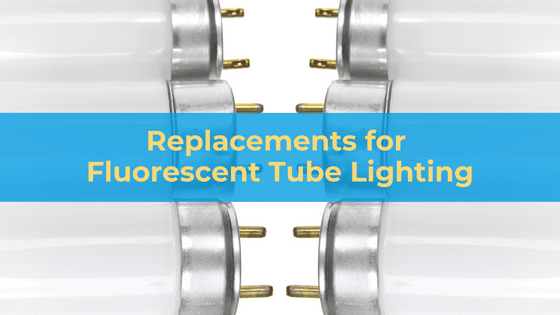
Obsolete, inefficient lighting is always being replaced by newer technologies, and it appears that fluorescent tubes are next in line. This is nothing new – incandescent bulbs are nearly extinct – but with the rise of high-efficiency options like LED lighting, fluorescent tubes are now a target for regulators.
In fact, some fluorescent lighting is already banned from manufacturing. If your facilities rely on it, you may be having issues sourcing fluorescent fixtures. In “light” of this, many facility managers are transitioning to LED lighting technology.
Compliance isn’t the only benefit, either. LED lighting has significant efficiency and longevity advantages that can help control operating costs.
What Fluorescent Tubes are Being Phased Out?
In 2009, the Department of Energy (DOE) instituted a ban on T12 tubes that was put in effect starting on July 14, 2012. Manufacturers were allowed to exhaust their remaining raw materials to produce and sell T12s, and extensions were handed out to a couple of major manufacturers.
Also, the DOE’s ban did not include high-CRI T12 fluorescent tubes, but several states have already extended the ban to include them. These states include:
- California
- Colorado
- Hawaii
- Maine
- Maryland (starting in 2024)
- Massachusetts (starting in 2023)
- Nevada (starting in 2024)
- New Jersey (starting in 2023)
- Oregon (starting in 2023)
- Vermont
- Washington (starting in 2023)
In addition to high-CRI T12s, these bans also include high-CRI T8 tubes. It’s likely that as LED tubes become more popular, additional states will institute their own extended restrictions on fluorescent tube manufacturing.
What are the Replacement Options for Fluorescent Tube Lights?
We’re in the middle of a major lighting transition, and the number of LED replacement options is growing all the time. A few of those options include:
- LED retrofit tubes – Retrofit tubes are a popular choice for property owners because they cost less than a full fixture replacement, while still providing most of the benefits that come with LED lighting.
LED retrofit tubes are designed to fit into existing fluorescent fixtures, and they come in a few varieties. Type A tubes are designed to wire into the existing fluorescent ballast. Type B tubes are wired directly to the mains and bypass the ballast altogether. Type C tubes come with an integrated driver that’s used instead of fluorescent ballasts.
There are advantages and limitations with each retrofit tube type. Type A tubes are quick to install but may have compatibility issues with the existing ballast. Poor ballast/lamp compatibility isn’t an issue with Type B tubes, but installation is considerably more difficult and subject to more risk. Type C tubes provide the best performance but are the most expensive retrofit tubes on the market.
In all three cases, though, retrofit LED tubes are less expensive than full fixture replacements and provide the energy efficiency that LED lights are known for.
- LED T8 fixtures with an LED tube – There are also full fixture replacement options that incorporate the LED tube and fixture together. While these are more expensive than retrofit options, a full fixture replacement also unlocks the full capabilities of LED lighting technology. This means two things:
-
- Full fixtures replacement means there’s no fluorescent ballast involved. That improves energy efficiency further because the ballast is responsible for some of the power draw.
- Full fixture replacement are also compatible with modern lighting controls. This includes dimmer and occupancy controls, both of which can improve lighting performance and energy efficiency further.
- LED panels or troffers – LED panels and troffers can also replace your fluorescent tube fixtures while retaining the same footprint. Panels lie flush with the ceiling and provide frame-to-frame illumination while LED troffers are much like fluorescent troffers – recessed into the ceiling and finished with a tube fixture.
LED panels and troffers provide the advantages of LED lighting with the modern aesthetic that comes with these fixtures.
How Can LED Tube Lights Improve Facility Operations?
For availability reasons, facility managers will eventually need to transition to LED lighting. As long as there is budget room, there’s no reason to wait. Compared to fluorescent lights, LED tubes are an improvement in nearly every way. For example, LED lighting can:
- Reduce operating costs – LED lighting is the most energy efficient lighting technology available, which is why the DOE and state regulators favor it. That energy efficiency can also bring a facility’s energy costs down considerably. LED fixtures also last much longer than other lights. That means lower lamp replacement and maintenance costs. Together, these savings mean LED retrofits provide a quick ROI.
- Allow for better control – LED lighting is the best fit for advanced lighting controls. These controls can improve efficiency, sure, but they can also enhance security and productivity by providing illumination where it’s needed most, when it’s needed most.
- Produce higher quality illumination – LED lights have come a long way in quality since they were first introduced decades ago. As a replacement for fluorescent tubes, LED fixtures provide light that’s closer to natural sunlight in emission range. People tend to feel comfortable when subjected to natural light, compared to the greenish cast that fluorescent lights produce.
Need a Replacement Option for Fluorescent Tube Lighting? Consider an Upgrade to LEDs
T12 fluorescent tubes will soon be removed from the market entirely, and it likely won’t be long until T8s and T5s follow suit. Facility managers have decisions to make with their lighting, and many are deciding to upgrade to LED fixtures.
With rapid advancements in LED fixture technology in recent years, LED lighting is now accessible to most properties. That’s true even if you are operating with a tight budget. Retrofit tubes mean you don’t have to start from scratch, and LED lamps soon pay for themselves with their minimal energy and maintenance costs.






